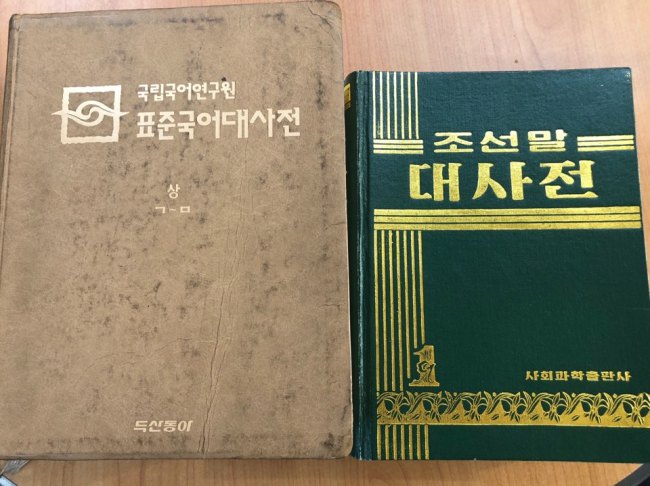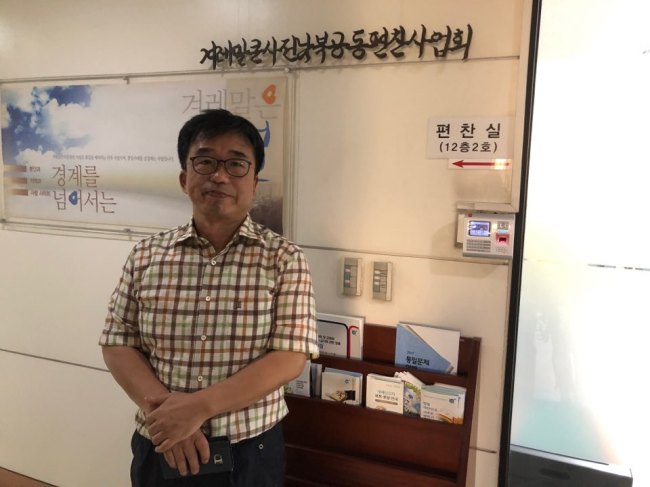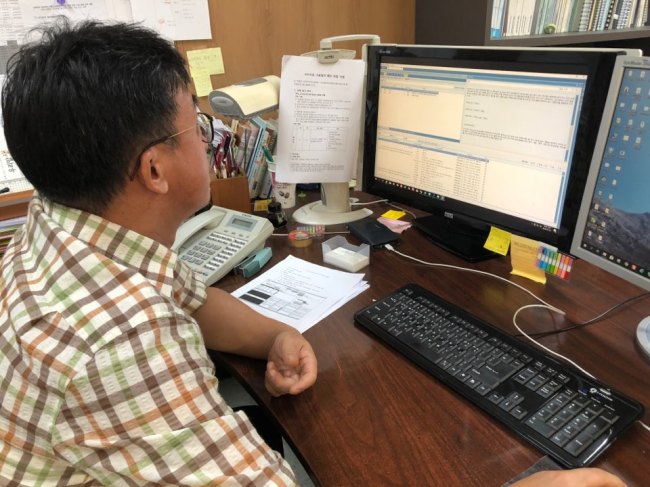The Korea Herald is publishing a series of articles featuring inter-Korean relations to mark the paper’s 65th anniversary that falls on Aug. 15. Following is the second installment. -- Ed
As the two Koreas strive to improve relations, a stalled project to bridge the linguistic gap between them could be revived.
While Korean is the official language of the two Koreas, the forms of the language spoken by South and North Koreans have drifted apart as a result of the differing cultures and social systems of the two sides.
The reconciliatory atmosphere initiated by the April 27 inter-Korean summit has brought a joint project to publish a unified dictionary back into the spotlight.
Language differences
 |
South Korea’s Standard Korean Language Dictionary (left) and North Korea’s Joseonmal Daesajeon (Jo He-rim/The Korea Herald) |
In February 2005, the two Koreas established the Joint Committee of South and North Korea for the Compilation of Gyeoremal-keunsajeon -- a unified and unabridged Korean dictionary -- to minimize confusion and lay the foundation of the language if reunification occurs. The South’s state-run Inter-Korean Cooperation Fund provides annual funding of about 3 billion won ($2.65 million).
Due to turbulent relations and high political tension, however, meetings were suspended several times and the project was brought to a halt in 2016, following provocative nuclear missile tests and the closing of the Kaesong industrial park.
“The differences in the language come largely from vocabularies that have developed to reflect the lifestyles of the two Koreas,” Han Yong-un, the chief of the compilation department at South Korea’s committee, told The Korea Herald.
Joint projects for unified dictionaries are not rare for countries that have experienced division. In 2016, China and Taiwan published a comprehensive dictionary that contains 101,732 entries. Efforts for linguistic unity were also made when East and West Germany reunified in 1990.
The inter-Korean committee, which consists of lexicographers and linguists from the two sides, has held 25 meetings since the project kicked off, to select about 330,000 entries for the Gyeoremal-keunsajeon.
According to Han, only about 6 words out of 10 are mutually understood by people in the two Koreas. With a greater discrepancy in technical terms, it is not easy, for example, for doctors or architects from the South and North to work together, Han said.
Language regarding banks, taxes and other areas determined by the political system in place also presents barriers.
“Once, we (the committee members) were deciding on the different categories of taxes to include in the dictionary. But because the tax system does not exist in North Korea, their lexicographers asked us, ‘What do you live with after paying off so much tax to the country?’”
In the joint dictionary, they agreed to take out detailed categories of taxes.
North Koreans and South Koreans would perceive the word “eunhaeng”-- bank in Korean -- differently because while bank transactions occur daily for all individuals in the South, they only occur between groups or entities in the North, Han said.
Along with the different vocabularies used, linguistic differences also come from political management.
In the South Korean dictionary, the term “dongmu,” is defined as “colleague, close acquaintance,” but in the North Korean dictionary, it is stated as “a revolutionary colleague who fights together under the same ideology.”
Bridging language gap is not power game
 |
Han Yong-un, chief of the compilation department at South Korea’s committee of Compilation of Gyeoremal-keunsajeon, poses in front of the office located in Gongdeok, Seoul, Wednesday. (Jo He-rim/The Korea Herald) |
Up to this year, the committee has been selecting 210,000 entries used widely in both or either South or North Korea’s existing dictionaries: the Standard Korean Language Dictionary, compiled by the South’s National Institute of Korean Language in 1999 and Joseonmal Daesajeon compiled by the North’s Academy of Social Sciences.
The rest of the words, about 70,000, were newly collected from written documents and regional language surveys conducted by the lexicographers.
In addition to choosing the entries and providing unified definitions, the committee members have to decide on the unified orthography, or the microstructure of the language.
While vocabularies differ, it is the users that will decide the standard forms of the terms, Han explained. For example, if the word “goose” in South Korea is called “geowi” and in the North “gyesani,” both terms will be included in the dictionary.
“Language evolves and vocabularies also compete with another. In time, the word that more people use will become the standard, and the less used ones may co-exist or disappear,” Han said.
As for the orthography of the Korean language, it is the role of the lexicographers from the two Koreas to decide. The orthographic differences include word spacing and varying pronunciations of initial syllables.
But reaching agreement in unified language rules does not mean trading a rule of South Korea with another of the North, Han said.
“When we reported the results of our meetings, people would talk about how many more South Korean rules were accepted compared to the North Korean rules,” Han said. “It is not a power game. We strictly follow linguistic rules and development of the language to see what would be the most efficient forms to transfer to later generations.”
But considering public sentiment toward unfamiliarity, it would take a long time for such differences to be settled, Han added.
Han explained that the project was more than just creating a dictionary with a list of words used in the two states -- it provided the opportunity to conduct a comprehensive check on the Korean language as well.
 |
(Jo He-rim/The Korea Herald) |
Stability for completion of the dictionaryWhile the series of meetings with the North is leading progress in talks for industrial cooperation, nongovernmental exchanges have yet to come.
In line with the thawing atmosphere, South Korea’s joint compilation committee wishes for its project to be resumed.
“We have not yet heard from the North to restart the project. We sent a request for a working-level consultation via fax mail, and are waiting for the response,” said Kim Hak-mook, the committee’s secretary-general.
The South Korean committee is working to extend its project operating period for another five years, as it is currently set to end in April 2019.
“While the dictionary-making business in the North is taken by its regime, it has mostly been done by private publishers in the South, so here it is also a temporary project with an end date,” Kim said.
The publication of the final version of the dictionary is expected take about six more years as it has to go through proofreading and copy editing.
As the governments of the South and North have agreed to set up a joint liaison office inside Kaesong industrial park located to the north of the border in August, Kim hoped the committee would be stationed at the liaison office to continue its work without interference.
By Jo He-rim (
herim@heraldcorp.com)







![[KH Explains] For Korean automakers, Chinese EVs may loom larger than Trump’s tariffs](http://res.heraldm.com/phpwas/restmb_idxmake.php?idx=644&simg=/content/image/2024/11/14/20241114050537_0.jpg)
![[Graphic News] Tainan predicted top destination for South Koreans in 2025](http://res.heraldm.com/phpwas/restmb_idxmake.php?idx=644&simg=/content/image/2024/11/13/20241113050807_0.gif)

![[Herald Review] Cho Seung-woo takes 'Hamlet' crown](http://res.heraldm.com/phpwas/restmb_idxmake.php?idx=644&simg=/content/image/2024/11/14/20241114050593_0.jpg)